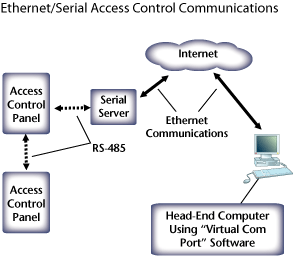Serial Communications and Ethernet
Many installations call for the inclusion or integration of access control communications and other monitoring and control functions, along with video and alarm monitoring. As the connection of access control equipment to Ethernet networks mirrors, in many ways, the technologies used to connect serial-based industrial processing and control systems, the following information is generally applicable to both types of installations.

How Do These Technologies Communicate?
Remote access control panels and industrial monitoring modules communicate with their controlling head-end computers through serial data protocols such as RS-422 and RS-485. These interfacing standards were established by the Electronic Industry Association, and were developed to provide communications between devices for machine-to-machine communications.RS-422 and RS-485
These data protocols transmit using asynchronous data communications, meaning that the data is sent one bit at a time, as shown in the diagram.
The two most commonly used serial protocols are RS-422 and RS-485. In both types of networks, transceiver modules are typically connected using single twisted copper pairs, and a separate signal ground conductor. Both RS-422 and 485 provide communications out to 4,000 ft. between devices, without the use of repeaters, which can extend that distance. This distance or the quantity of devices may vary depending on the equipment manufacturer.
RS-422 is typically used for point-to-point connections, while RS-485 offers the ability to connect up to 32 communication modules on a single network. Communications modules are addressed typically using a “Com 1, 2, 3…†scheme.
At the controlling computer, the RS-422 or 485 cabling is connected to a hardwired serial port, also called a Com Port, on the desktop or laptop PC. This connection requires some form of interface to the PC, to convert the RS-422 or RS-485 to RS-232 (i.e., the COM port on the PC), or directly into the PC via a specialized interface card. In the case of an access control system, the system management software will provide a selection for which Com Port is to be used to communicate over the RS-422/485 network.
Why Change to Ethernet?
While these protocols are useful for relatively short distances, there are two reasons that it’s beneficial to convert these protocols into Ethernet data. The first is the distance issue, as the conversion to Ethernet will allow devices to communicate over the WAN or Internet, allowing connections to devices across town or around the world. The other reason is that converting RS-422/485 signals into Ethernet provides the ability to control remote devices with standard PCs connected to the network, without separate connections for the RS-type communications. This allows the existing cabling to be used, leveraging network investments.
Ethernet Converters/ Serial Servers
To enable Ethernet communications with one or a network of RS-422/485 devices, a serial server is installed, which connects to the LAN/Internet and to the serial communications bus. Serial servers typically are available with 1, 2, 4, 8 or 16 serial ports. With the proper connections and IP address programming, the serial server becomes a node on the network, and can be remotely accessed to download data, interrogate, or change the programming of the connected RS-422/485 device(s). If multiple devices are connected to the serial server, they are accessible using their “Com 1, 2, 3…†types of individual serial addresses, once the serial server has been reached by the controlling computer. Serial server devices are also available for the RS-232 protocol.Head-end Communications
At the head-end computer, Virtual Com Port software is installed, which associates a COM port connection with the specific IP address of the virtual server connected to the RS-422/485 network. The Virtual Com Port program converts serial commands and communications into Ethernet packets, which are transmitted over the LAN/Internet and processed by the remote virtual server, providing communications to the devices connected to the RS-422/485 network.
Serial Tunneling
A second connection option provides the ability to establish constant two-way communication between one RS-422/485 device (or network or devices) and another, with or without the inclusion of a PC or intelligent device. In a manner similar to establishing an Ethernet bridge, serial tunneling is accomplished using two serial servers that are programmed to constantly communicate with each other. Also called a Nailed Down configuration, this arrangement makes the Ethernet and cabling transparent to the serial communications flowing from one serial server to the other.This type of connection can be utilized to connect a remote RS-422/485 network to a monitoring computer, using a hardwire serial port on the computer.
Looking for a reprint of this article?
From high-res PDFs to custom plaques, order your copy today!





